- Products
- Solutions
- Services
- Resources
- Customer Success
- Company
- Sign In
- Contact Us

Digital Transformation enabler helping enterprises evolve by connecting technology
Take a look at upcoming webinars and special events
HokuApps news and media coverage
Be with the best. Solve real problems
Get in touch with our experts here
Explore our extensive collection of online resources here
Information and insight on transformation to the Digital Workplace
Quick Guides provide concise information on a variety of topics
Discover the essence of HokuApps’ products
Learn all about HokuApps’ cutting-edge enterprise mobility technology

Modern enterprises started relying on the rapid application development (RAD) phases and methodologywhen creating mobile and web applications to meet their business requirements. However, most businesses are still in the early adoption phase and are yet to comprehend the benefits of this low-code RAD model and its capacity to enhance their business success rates.
One of the major benefits of the rapid app development methodology is that it brings IT and businesses together, thereby fostering an iterative and collaborative development process. The core feature of this developmental tool is that it delivers projects in smaller, manageable pieces, thus reducing the overall project risks. Low-code rapid app development are thus emerging as the key enablers to innovation and transforming the way custom enterprise apps are developed and deployed so that businesses can stay ahead of the curve.
This content piece highlights the best features of a rapid system development methodology and will help you evaluate its suitability for your enterprise.
Whether it is about transforming application delivery or testing waters with a pilot project (with a prototype), selecting the appropriate business use case is imperative for achieving success with rapid application development methodology.
For instance, rapid app development methodology usually claim to be a ‘No Vendor Lock-in’ software and many such software end up using proprietary technologies and application stacks. Therefore, using rapid application development phases that supports open source technologies is more a necessity today, as it ensures an open and extensible software for application delivery. The HokuApps low-code RAD model is also a best-of-breed application stack for developing full stack applications as it enhances the adaptability and flexibility of the low code software.
When choosing a rapid app development model for your business, you should carefully consider if the RAD methodology provides easy external integration of data and services, since most business data is stored in disparate, proprietary systems. Therefore, businesses should be on the lookout for ‘out-of-the-box’ functionality since it allows direct integration of different applications and services on various tools.
Some rapid application development model merely provide a hosting and release management solution. RAD should support rapid and continuous provisioning and maximum utilization of resources. Businesses should also ensure that the phases supports the building of custom software stacks and deployment of micro services-based apps and successfully automates the IT infrastructure.
Therefore, when choosing a low-code rapid app development methodology, businesses should verify if it provides instant scalability and Cloud computing capabilities. HokuApps does provide instant scalability and secure Cloud computing services. HokuApps takes a very proven and structured approach to creating mobile apps.

This phase is all about the flow of information to various business channels and is an important and fundamental stage in RAD rapid application development where initial planning and analysis is usually accomplished. During this phase, it is possible to get a complete picture of business process functionality. Some of the common deliverables produced in this phase include the following – project definition, project management procedures, and work plan. In other words, it is also the stage where designers, developers, and users join forces to agree upon business needs, project scope, and application or system requirements.
The data modeling phase takes over after the conclusions of the business modeling phase. The information gathered during the business modeling phase is now reviewed and analyzed to define a set of clear data objects crucial for the business. This phase also helps to determine the rad system development architecture from the user feedback thereby allowing for the creation of prototypes. This step is repeated several times as the project evolves. An important deliverable produced during this stage is the reusable design components that are incorporated into the rad system development methodology.
The next phase in HokuApps’ rapid app development is the process modeling phase where the actual coding, testing, and integration take place. In other words, any changes or enhancements to the data objects are defined in this phase to establish business information flow. Similar to the data modeling phase, the process modeling phase is repeated as many times as necessary since new components may be required and alternations have to be made to meet project objectives.
This is the phase where the application is developed and the coding is completed. Therefore, during this phase developers use automated tools for the construction of the software, thereby, converting processes and data models into prototypes. The team then moves the programming components to a live production environment to conduct comprehensive testing. During the testing phase, each of the prototypes is tested independently during iteration. Thus, significantly reducing the overall testing time. The HokuApps rad system development also reduces the risk of any major issues since almost all programming components are tested in advance.
Frequent iterations, reusability of components and prototyping are some of the common features of the HokuApps rapid app development model. These features allow developers to measure the project’s overall rate of progress and simultaneously, maintain and evaluate schedules and budgets. The rapid application development methodology allows skilled software developers transitioning into multi-discipline roles (such as full-stack developers) to rapidly generate prototypes and working codes within days that might otherwise take weeks or months when using traditional development techniques. Similar to the object-oriented programming paradigm that keeps objects and components masked from one another, the rad system development framework, too, allows designers and developers to create components that are functional and independent of one another – components which could be used in iterative release processes or prototypes. As a result, each element within the software architecture is compartmentalized so that it can be modified as the software evolves with user feedback, and process and market demand changes.
Relevant user feedback through every stage of software development is invaluable. The rad system development model supports regular user interfacing thereby, enabling developers to gain greater user insight and receive feedback through frequent iteration and prototype releases. Thus, the entire development team receives priceless evaluation during the most critical stages of the development cycle. In the waterfall model approach, for example, developers need to wait until the very end of the lifecycle to begin integration with other systems or services. The rapid application development model, on the other hand, supports integration from the very beginning thereby solving numerous integration issues. By allowing early integrations within prototypes, the RAD model seamlessly identifies potential errors (bugs) or complications within integrations and brings about immediate resolutions.
Software, by its very nature, is malleable and is susceptible to dramatic changes that can alter the entire software system. Therefore, development teams should make good use of rapid application development phases early in the development cycle since the software focuses on the reusability of components and the reuse of codes.

Like all software development models, most rad system development solutions are not without its flaws. Although the advantages far outweigh its disadvantages, this section nonetheless will examine some of the potential pitfalls of this model.
Most rapid application development models depend heavily upon technically skilled developers because only highly skilled developers can easily adapt to the rapidly changing software system and its components. Another drawback would be its affinity towards systems that can be modularized thereby, allowing a variety of team members to modify or swap elements in and out using the rapid application development model. In other words, only those systems that can be modularized can be built using RAD.
Also, its dependency on frequent user interfacing can act as a double-edged sword since this approach requires equal and sustained commitment from both users and developers and the development team may not always be willing to communicate with users on a frequent basis thereby resulting in the failure of rapid application development projects.
At HokuApps, we have taken care of the chicks in the RAD armor. HokuApps low code rad system development uses pre-modeled templates, based on industries and requirements so that few developers with top-grade experience and training can create apps with drag and drop options in RAD system development. This reduces hand-coding by more than 80% while reducing bugs in the system to a bare minimum. This not only saves time and costs but also allows a sustained commitment by HokuApps IT support so that the app stays on positive shores.
Although both rapid application development Phases and other traditional SDLC models equally enhance the quality of the software, listed below are some of the more obvious differences between them.
The rapid application development (RAD) SDLC model follows the incremental and iterative approach while traditional SDLC models typically follow a more linear and predictive approach. The HokuApps rapid application development model focuses on delivering projects in rapid application development phases. In other words, RAD Phases a large project is divided into a series of smaller projects that are planned and delivered individually. Rapid application delivery requires small teams with advanced technology skills while traditional SDLC models require large teams with clearly defined roles and technology skills.
While the rapid application delivery models support testing at every iteration, in case of traditional SDLC models, testing is performed at the very end of the coding phase. Lastly, the rapid application delivery model allows extensive user interfacing where developers can interact with end users at every step of the process. In case of traditional SDLC models, developers interact with users during the requirements stage and then finally during the acceptance stage.
The HokuApps rapid application development phases outguns traditional SDLC model as it provides RAD Phases for businesses to become more agile, perform optimally, provide better customer engagement and outperform the competition. With cutting-edge technology at their fingertips, the HokuApps rapid application development phases deliver mobile apps for business at rapid speeds and enterprise-grade quality.